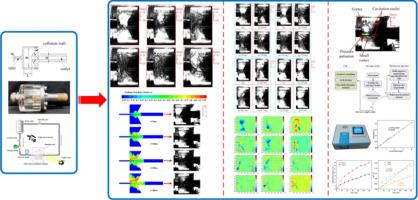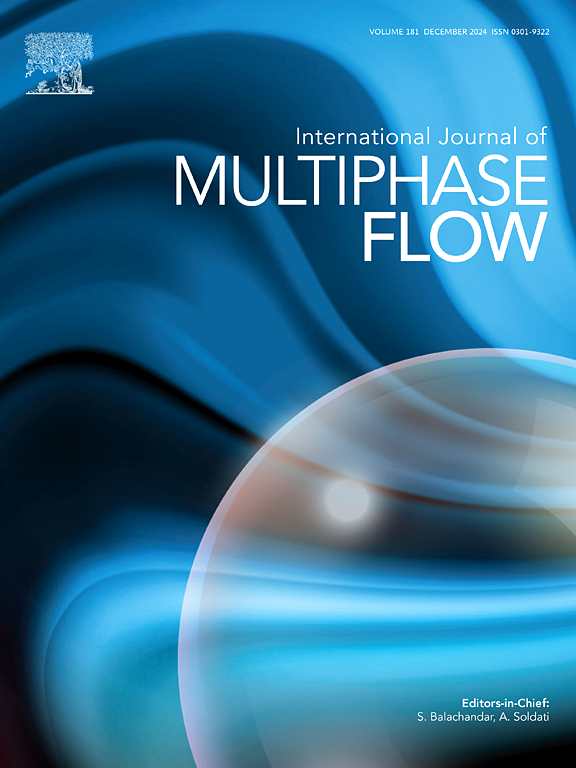Analysis of the vortex-pressure coupling mechanism in cavitation dynamics for self-excited oscillation nozzles and its structural optimization
IF 3.8
2区 工程技术
Q1 MECHANICS
International Journal of Multiphase Flow
Pub Date : 2025-09-09
DOI:10.1016/j.ijmultiphaseflow.2025.105442
引用次数: 0
Abstract
This study investigates cavitation dynamics in a self-excited oscillation nozzle (SEON) under gravitational influence using high-speed imaging, computational fluid dynamics (CFD) simulations, Proper Orthogonal Decomposition (POD), wavelet analysis, and multi-objective optimization with Dynamic Adaptive NSGA-II (DANSGA-II). High-speed imaging displays the formation, detachment, and collapse of cavitation cloud. CFD simulations reveal the internal flow field and vapor distribution, clarifying cavitation evolution in the SEON chamber. POD and wavelet analyses demonstrate a nonlinear relationship between cavitation behavior and inlet pressure, with peak performance at 1.5 MPa. A novel vortex-pressure pulsation coupling mechanism was proposed to explain cavitation cloud development. This mechanism guided structural optimization by selecting chamber length (L), impingement wall angle (α), and outlet contraction ratio (d2/D) as design variables. Multi-objective optimization using DANSGA-II produced optimal nozzle designs. For example, in Case 1 (L = 10.1 mm, α = 103°, d2/D = 0.1881), the mean vapor volume fraction increased by 59.18 %, and turbulent kinetic energy rose by 32.32 %. Methylene blue degradation experiments showed a 15.88 % removal efficiency after 120 minutes, improving 77.8 % over the baseline. This study investigated a vortex-pressure coupling mechanism through integrated visualization and simulation techniques, thereby facilitating the structural optimization of SEONs and enhancing cavitation performance. The findings provide both theoretical insights and practical guidance for the design and application of SEONs in industrial cleaning and wastewater treatment processes.

自激振荡喷管空化动力学涡压耦合机理分析及结构优化
采用高速成像、计算流体力学(CFD)模拟、正交分解(POD)、小波分析和动态自适应NSGA-II (DANSGA-II)多目标优化等方法,研究了重力作用下自激振荡喷管(SEON)的空化动力学。高速成像显示空化云的形成、分离和坍缩。CFD模拟揭示了SEON腔室内部流场和蒸汽分布,阐明了SEON腔室内空化的演化过程。POD和小波分析表明,空化行为与进口压力之间存在非线性关系,在1.5 MPa时达到峰值。提出了一种新的涡压脉动耦合机制来解释空化云的发展。该机制以腔长(L)、冲击壁角(α)和出口收缩比(d2/D)为设计变量指导结构优化。使用DANSGA-II进行多目标优化,得出最佳喷嘴设计。以情形1为例(L = 10.1 mm, α = 103°,d2/D = 0.1881),平均蒸气体积分数提高了59.18%,湍流动能提高了32.32%。亚甲基蓝降解实验表明,120分钟后,亚甲基蓝的去除率为15.88%,比基线提高77.8%。本研究通过综合可视化和仿真技术研究涡压耦合机理,从而优化SEONs结构,提高空化性能。研究结果为SEONs在工业清洗和废水处理过程中的设计和应用提供了理论见解和实践指导。
本文章由计算机程序翻译,如有差异,请以英文原文为准。
求助全文
约1分钟内获得全文
求助全文
来源期刊
CiteScore
7.30
自引率
10.50%
发文量
244
审稿时长
4 months
期刊介绍:
The International Journal of Multiphase Flow publishes analytical, numerical and experimental articles of lasting interest. The scope of the journal includes all aspects of mass, momentum and energy exchange phenomena among different phases such as occur in disperse flows, gas–liquid and liquid–liquid flows, flows in porous media, boiling, granular flows and others.
The journal publishes full papers, brief communications and conference announcements.

 求助内容:
求助内容: 应助结果提醒方式:
应助结果提醒方式:


